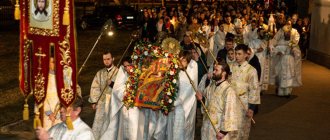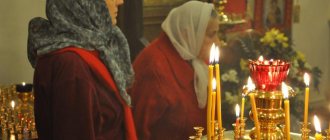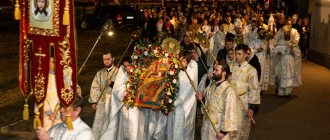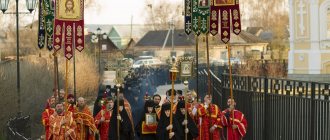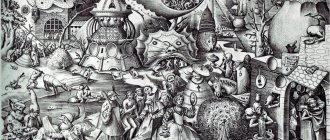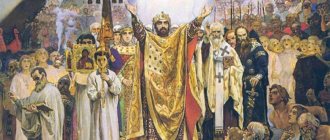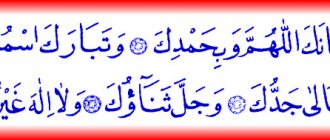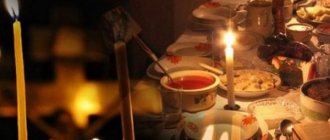In Orthodox churches, as well as in Catholic churches that perform Eastern liturgical rites in their religious life, it has become a tradition to organize solemn processions with banners and icons, in front of which a large cross is usually carried. From him such processions received the name of religious processions. These could be processions organized on Easter week, Epiphany, or on the occasion of any significant church events.
Birth of a tradition
Processions of the cross are a tradition that came to us from the first centuries of Christianity. However, during the times of persecution of followers of the evangelical teaching, they were associated with considerable risk, and therefore were carried out in secret, and almost no information about them has been preserved. Only a few drawings on the walls of the catacombs are known.
The earliest mention of such a ritual dates back to the 4th century, when the first Christian emperor Constantine I the Great, before the decisive battle, saw in the sky the sign of the cross and the inscription: “By this victory.” Having ordered the production of banners and shields with the image of a cross, which became the prototype of future banners, he moved a column of his troops towards the enemy.
Further, the chronicles report that a century later, Bishop Porfiry of Gaza, before erecting another Christian temple on the site of a ruined pagan temple, made a religious procession to it to consecrate the land desecrated by idolaters.
Emperor in hair shirt
It is also known that the last emperor of the united Roman Empire, Theodosius I the Great, used to perform religious processions with his soldiers every time he went on a campaign. These processions, preceded by the emperor, dressed in a hair shirt, always ended near the tombs of the Christian martyrs, where the honorable army prostrated themselves, asking for their intercession before the Heavenly Powers.
In the 6th century, religious processions in churches were finally legalized and became a tradition. They were given such great importance that the Byzantine emperor Justinian I (482-565) issued a special decree according to which it was forbidden for the laity to perform them without the participation of clergy, since the pious ruler saw in this a profanation of the sacred rite.
The most common types of religious processions
Having become over time an integral part of church life, religious processions today take a wide variety of forms and are performed on a number of occasions. Among them the most famous are:
- The Easter religious procession, as well as all other processions associated with this main holiday of the annual Orthodox circle. This includes the religious procession on Palm Sunday ─ “walking on a donkey.” On Holy Saturday, the prototype of the procession is the removal of the shroud. It is celebrated at Easter Matins (this will be discussed in more detail below), as well as daily during Bright Week and every Sunday until the day of Easter.
- Processions of the cross on the days of major Orthodox holidays, as well as patronal holidays, celebrated by the community of a particular parish. Such processions are often organized in honor of the consecration of temples or celebrations dedicated to especially revered icons. In these cases, the route of the religious procession runs from village to village, or from temple to temple.
- To consecrate the water of various sources, as well as rivers, lakes, etc. They are performed on the day of the Epiphany of the Lord (or on the Christmas Eve preceding it), on Friday of Bright Week ─ the feast of the Life-Giving Spring, and on August 14, on the day of the Carrying of the Venerable Trees of the Life-Giving Cross of the Lord .
- Funeral processions accompanying the deceased to the cemetery.
- Associated with any, as a rule, unfavorable life circumstances, for example, drought, floods, epidemics, etc. In such cases, a religious procession is part of a prayer service for the intercession of the Heavenly Forces and the sending of deliverance from the disasters that have befallen, which include also man-made disasters and military actions.
- Inside the temple, performed on a number of festivals. Lithium is also considered a type of religious procession.
- Performed on the occasion of any public holidays or major events. For example, in recent years it has become a tradition to celebrate National Unity Day with religious processions.
- Missionary religious processions held with the aim of attracting non-believers or followers of other religious teachings into their ranks.
Perov's code of the cross
1862 Saint Petersburg.
...Grand Duchess Maria Nikolaevna was seriously angry, and the fan in her hands shook angrily, foreshadowing a storm. It was all to blame for this terrible scandal at the opening of the traditional exhibition of the Imperial Society for the Encouragement of Artists, under which Maria Nikolaevna was the chairman of the trustee committee. Moreover, rumors about the vile picture, which plunged the entire elite of St. Petersburg into agitation, reached the ears of His Imperial Majesty in a matter of days.
- Fyodor Fyodorovich, my dear, how did you allow such a dirty trick?! – Without hiding her irritation, the princess asked the secretary of the Society, nobleman Lvov.
But he only shrugged his shoulders with exaggerated carelessness:
– New trends, Your Imperial Highness, now rule not only in politics, but also in the minds of young people, including among young daring painters who are planning to transform the entire world of Russian fine art...
- Enough, prince! – a sharp wave of the fan interrupted Lvov’s prepared speech. – None of these “trends” of yours can become a justification for blasphemous attacks on the Holy Orthodox Church! Where did this nihilist even come from, who brought him?!
– Vasily Perov, student at the Academy of Arts of His Imperial Majesty. Professors find him a future genius in the horizon of Russian painting...
- Is that so?! A genius?! – the princess frowned angrily.
V. Perov. Self-portrait
The worst thing is that the newly appointed Chief Prosecutor of the Holy Synod, Major General from the cavalry Akhmatov, also turned his attention to the disgusting picture, who was just looking for an opportunity to distinguish himself in a new field and pin down all these civilian staffers, who, apparently, are the cold wind of freedom not only turned my head, but also thoroughly blew my head away. Moreover, after the peasant riots that broke out after the Manifesto of 1861, the sovereign gave the chief prosecutor a real carte blanche to eradicate all freethinking, and one can imagine how this soldier in a cassock will establish his army order in her diocese. Therefore, the scandal had to be extinguished as soon as possible.
“Fyodor Fedorovich,” metallic notes began to sound in Her Highness’s voice.
– Remove this vulgarity immediately, and best of all, burn it in a stove out of harm’s way...
– I just can’t, Your Imperial Highness!
– What exactly can’t you do?! – the fan folded in the princess’s hands with a deafening crash.
“I can’t burn it, Your Highness.” This painting has already been acquired by a certain Moscow merchant - Mr. Tretyakov...
- Tretyakov? – the merchant’s surname meant absolutely nothing to the princess. Probably some nouveau riche commoner. However, it didn't matter.
- Remove this abomination anyway. And tell your “genius” and his patrons that they will end up exiled to Siberia!
Vasily Perov. Procession for Easter
The Grand Duchess had no idea that the young rebel Perov had just been born in Siberia, so it was impossible to frighten him with exile and deprivation.
The painting “Rural Procession at Easter” was banned from showing, but it still became one of the most famous in the empire. Moreover, in the twentieth century, Perov’s paintings began to be used to illustrate anti-clerical articles in newspapers and magazines denouncing church morals.
And even today on the website of the Tretyakov Gallery, which houses Perov’s painting, it is written: “A drunken procession with icons and banners drags sadly past the viewer. Peasants with half-closed eyes wander towards the cliff, like blind people. The guide who abandoned them is a drunken priest who crushed an Easter egg with his foot. Nearby is a woman with an icon whose face has been lost. At a distance is a beggar carrying an icon upside down. But the All-Seeing Eye on the banner is like a warning that these people cannot escape the Supreme Court...”
But let us not repeat the fabrications of Soviet propagandists. For example, Fyodor Dostoevsky, who after hard labor could not stand ambiguous ironic allusions towards the church, spoke very positively about the Procession of the Cross: “Almost everything in Perov is true, that artistic truth that is given to true talent.”
Perov was also praised by other critics - for example, the writer Kovalensky, who saw in the film not just “blasphemy” and “anti-clericalism”, but the most sincere pain and empathy for the fate of the state Orthodox Church in the Russian Empire. That very pain that for some reason today’s believers do not see.
So what was Perov's painting really about?
* * *
During his short life (the artist died of consumption when he was not even 50 years old), Vasily Perov managed to make a real revolution in painting. He brought into the galleries the life of the streets, the faces of ordinary people, the greyness, dirt and poverty, about which he knew more than enough.
He was the illegitimate son of the real Baltic baron Georgy Karlovich Kridener, whose family owned vast estates near Dorpat. True, his older brother Moritz lived in Suslep’s family nest, but the younger brother, George, went into public service. And by the age of 50, Georgy Karlovich became the prosecutor of the Tobolsk province.
In Tobolsk, he began adultery with a local bourgeois woman, Akulina Ivanova, who soon gave birth to a son, Vasya, around the end of December 1833. The exact date of birth of the artist is unknown, since the birth itself took place in complete secrecy, and Akulina Ivanovna recorded her son in the church register only a few years after his birth.
In addition, Vasily was recorded under the fictitious surname “Vasiliev” - in honor of a certain Vasily, who became the baby’s godfather.
Nevertheless, Baron Kridener failed to keep the birth of the child a secret. Soon denunciations came to St. Petersburg, which cost Georgy Karlovich not only his family (his wife immediately filed for divorce), but also his prosecutor’s post.
But Georgy Karlovich behaved like a real nobleman: he not only recognized his son, but also made an official proposal to Akulina. (Later two more boys were born into the Kridener family - George and Nikolai.)
Nevertheless, young Vasily Vasiliev did not receive either his father’s surname, no noble class, or rights to a baronial title and coat of arms - all this, according to the laws of the Russian Empire, was reserved only for legitimate children.
He did not receive his father’s money either: Baron Kridener already had official heirs - children from Georgy Karlovich’s first marriage, who received estates in the Samara province.
The second family of Baron Kridener eked out a rather miserable existence.
From Tobolsk, Georgy Karlovich was sent to Arkhangelsk, but Baron Kridener did not take root there either. It was all because of the epigrams he wrote about the local governor-general. Denunciations again flew to the capital, and Kridener was dismissed.
For some time they lived on an estate with their older brother near Dorpat, but even there the bilious Georgy Karlovich could not settle down.
Soon the family moved to the Sablukovo estate in the Arzamas district of the Nizhny Novgorod province, where Baron Kridener received the position of manager from the local landowner Yazykov.
It was in this village that Vasily received his second name - Perov. As the artist himself recalled many years later, this nickname was given to him by the deacon of the local church, to whom the boy was sent to learn to read and write. At the same time, another student, the dim-witted son of a wealthy peasant, was studying with the sexton. And while the future artist diligently traced letter after letter, the second student did nothing but dangle his legs. Once a teacher, driven to white heat by a careless student, exclaimed:
“Where should I write to you, just dangle your feet, and you will be Ivan Boltov, but he will be Vasily Perov!”
Vasily liked the nickname so much that he decided to make it his official pseudonym, and then that was the only way he signed his works.
Also in Sablukovo, Vasily fell ill with smallpox. The consequence of this disease - poor vision - remained with him for the rest of his life.
When the boy was 10 years old, Vasily was sent to study at the Arzamas district school. And then his career went in full accordance with the royal decree of Peter the Great, who commanded: “Give bastards to be artists.”
At that time, the painting school of Alexander Vasilyevich Stupin was operating in Arzamas - the first provincial art school, which, however, was more like an icon-painting workshop. Stupin accepted orders from local churches for iconostases and painting of the churches themselves, and all the work was done by school students.
For almost ten years, Vasily Perov studied and worked at Stupin’s school, where he became very closely acquainted with the behind-the-scenes side of the life of Orthodox priests, which is very different from the lives of holy ascetics with ascetic deeds and suffering for the faith.
At the age of 20, Vasily Perov decided to try his luck in Moscow and entered the Moscow School of Painting and Sculpture. As the artist himself recalled, his years of study became the most difficult test for him: the money he earned from Stupin ran out, he had nothing to pay for tuition and a rented room, and he had no source of income.
Vasily Perov. Portrait of N.G. Kridener, the artist's brother
“I already wanted to go to the province as an art teacher,” he wrote to one of his friends. “But some inner voice told me that there was no need to rush into this; Moreover, one instinctively felt that it would not take long to commit moral suicide, but at the age of 22 it was unbearably bitter to recognize one’s uselessness even to oneself. I hesitated... what was I hoping for, what was I waiting for? Really, I don’t know..."
Once he even fainted from hunger, and then one of the school teachers, Yegor Vasiliev, having learned about Perov’s cramped circumstances, offered to live with him in a government apartment. (As Perov himself wrote, many art teachers, out of a sense of solidarity, often allowed poor students to stay with them, in whom they saw God’s spark.)
Vasily Perov. Arrival of the police officer for investigation
The teacher was not mistaken. Already in 1856, Perov’s painting - a portrait of his younger brother Nikolai - received a small silver medal from the Academy of Arts in St. Petersburg. His next work, “The Arrival of the Stanovoy for Investigation,” already won a Big Silver Medal.
It was at this moment that Perov realized what and how he now needed to write. Then one of the most popular books was “Provincial Sketches” by Saltykov-Shchedrin, in which the writer mercilessly denounced the order of “old Russia.” Sensitive to manifestations of public interest, Perov decided to create his own gallery of folk images. And he started with the church - fortunately, his youthful impressions of working in rural churches were still fresh.
In 1860, the Academy awarded Perov a Small Gold Medal for his painting “First Rank. The son of a sexton, promoted to collegiate registrar.”
Vasily Perov. Son of a sexton promoted to collegiate registrar
Having received the right to participate in the competition for the Big Gold Medal, Perov moved to St. Petersburg. In 1861, he painted the paintings “Sermon in a Village” and “Rural Procession for Easter.”
And if for the first painting he received the Grand Gold Medal of the Academy and the right to travel abroad as a boarder, then the second painting was bombarded with curses and prohibited from being shown.
Alexander Benois, in his landmark work “The History of Russian Painting,” mercilessly castigated Perov, a “nihilist” of art:
“Being a very impressionable and nervous person, Perov could not remain indifferent during the general frenzy, and his paintings began to reflect the bilious bitterness that took possession of advanced Russian society in the early 60s... The painting that appeared in the year of the liberation of the peasants was daring , quite a “Bazarovsky”, in its harshness, trick. “Sermon in the Village” is depicted in completely gloomy colors. There is not the slightest light. And the clergy, and the peasants, and the landowners are presented in such an unattractive form that, looking at this picture, the viewer can only fall into despair... The famous “Religious Procession on Easter” was especially poisonous in nature - truly a terrifying picture of village morals... Nothing like this in Russian painting had never been seen before, and even today this dark, nondescript picture produces a very strong hostile impression...”
Vasily Perov. Sermon in the village
Perov's painting really caused heated debate. Nihilists and the “advanced” public, who professed Chernyshevsky and Pisarev, received it with a bang.
Critic Vladimir Stasov, who noted that Perov’s satire “bites painfully,” at the same time praised the film for its truth and sincerity, for its correctly noticed and conveyed types.
Other critics, on the contrary, argued that such “caricatures” kill real high art, humiliate it, showing only the unsightly side of life.
The Chief Prosecutor of the Holy Synod, General Akhmatov, who intervened in the discussion, decided to ban public displays of Perov’s painting, and the merchant Tretyakov was even required to sign a subscription with an obligation not to lend the painting to any exhibitions.
But Vasily Perov was not intimidated by subscriptions. In the same 1862, he painted a new picture - “Tea Party in Mytishchi”. An obese monk drinks tea with voluptuous pleasure, sitting on a quiet, clear day under the shade of dense trees. And next to him stands a blind, crippled soldier with a boy guide who asks for alms.
But let's think about how a blind beggar got into the church garden where the monks are having tea? After all, such a garden is usually surrounded by a strong fence and securely locked. Maybe the beggar was deliberately allowed to come to the table?
In the same way, the painting “Rural Procession on Easter” does not depict at all what nihilists and liberals admired so much.
* * *
So, if we carefully look at what is happening in the picture, we will find that its title, to put it mildly, does not correspond to the content. However, as the artist Vasily Khudyakov testified, Perov himself called his painting “Pop” - this was a generally accepted abbreviation of the words “shepherd of Orthodox sheep” at that time. But the owner of the painting, Pavel Tretyakov, was against such broad generalizations and changed the title of the painting to “Rural religious procession on Easter.”
Vasily Perov. Tea drinking in Mytishchi
Apparently, Tretyakov himself had little understanding of the intricacies of church rituals, otherwise he would have seen that the picture does not depict a religious procession at all, that is, not part of the Easter service, when the clergy, clergy and parishioners solemnly parade around the temple, as if recalling the majestic processions of the first centuries Christianity. (In ancient Byzantium, it was on Easter - once a year - that the baptism of newly-churched Christians took place, and from the baptistery churches with baptismal fonts, a procession of neophytes went to the temple for the first liturgy - in memory of this, the tradition of the Easter procession was established.)
No, the “god-bearers” depicted in Perov’s painting (that’s what the peasants in the village were called who agreed to wear icons and banners throughout the Easter week) do not come out of the temple at all, but from an ordinary village hut. Or, most likely, from a tavern - while the temple itself is drawn on the left in the distance.
Action time: evening. That is, this is not Easter midnight, when, in fact, the religious procession took place in Orthodox churches. And this is not the morning of one of the days of Bright Week, when the course is repeated.
Finally, pay attention to the priest’s vestments: his mantle and stole are blue, while for the religious procession the priest wears white or red vestments, depending on the time of day. The blue color of the vestment means that the priest is performing “requirements” - or rather, the ritual of “glorification”, which no longer exists in modern church practice.
“Glorification” means long walks through the huts of parishioners to collect alms.
Of course, in former times all respectable Christians gave a tithe to the church, that is, a tenth of their income. For example, the very first Orthodox church, built by Equal-to-the-Apostles Prince Vladimir the Red Sun, was called the Tithe Church, because the church was built at the expense of the prince’s church tithes. But already in the Middle Ages, the tradition of paying tithes became a thing of the past. A significant role in this was played by the church schism of the 17th century, and the accelerated Europeanization of the country under Peter the Great, and the state policy of secularization of church properties, when the tsarist government, taking away from the church property and valuables donated by parishioners, assigned the church maintenance at the expense of the state budget.
During the reign of Nicholas I, the government finally formalized the Russian Church as a “ministry of spirituality,” and clergy became salaried civil servants. The salary, however, was insignificant, and it is no coincidence that Metropolitan Arseny of Kiev and Galicia wrote in the same 1862: “We live in an age of cruel persecution of the faith and the Church under the guise of insidious care for them.”
For example, at the beginning of the twentieth century, the salary of an archpriest was 200–300 rubles a year, a deacon’s salary was 100–150 rubles, while a primary school teacher received 400–500 rubles a year (a gymnasium teacher received significantly more).
But even these small amounts were allocated only to a small part of the clergy who served in the cities. Rural parish priests had to feed themselves “from the land,” that is, they were content with the funds that they managed to collect from parishioners for performing three main “requirements”: the rites of baptism, funeral service and wedding (the church kept metric books, and from procedures related to metric recording, the peasants could not get away with it).
It is clear that the most expensive ceremony was the wedding: for it the priest could receive from 3 to 10 rubles, depending on the welfare of the couple. But they carried out baptism and funeral services practically free of charge - many peasants themselves did not have money. Therefore, in order to provide for their families, priests and deacons were forced to run their own households, and on major holidays - Christmas or Easter - they went to the surrounding villages for “praises” - in other words, they begged for money for the consecration of houses.
At the “glorification”, a procession with “god-bearers” entered each hut, benevolent prayers and psalms were read, for which the peasants paid the guests: someone gave a penny, but most often they served food and poured a glass or two of village bread moonshine, saying:
- Father, drink, it’ll be a quarter for you, but if you don’t drink, it’ll be a nickel!
And they drank. So by the end of the event, often all participants in the event were drunk, as they say, “to the point of drunkenness.”
Moreover, as the daughters of priest Sergius Samuilov wrote in their book of memoirs, “The Father’s Cross,” many priests were very dissatisfied with both their forced begging and drunkenness. But in anticipation of the moment when the state finally remembers the poor parish priests, they simply had no choice but to go to “praises.”
And Perov denounced not the licentiousness of the priests, but the state itself, which first shamelessly robbed the church, and then drove the clergy into a humiliated and powerless position.
But the trouble is that - as then, so now! - people from the educated intelligentsia saw only the unsightly outer side of the church, not understanding how the life of a simple rural priest worked in general. Suffice it to recall how Chekhov describes in his story “Nightmare” the impression of the young official Kunin from St. Petersburg, spoiled by life, from meeting a poor village priest, whose clothes were dirty and worn out:
“What a strange, wild man! Dirty, slovenly, rude, stupid and, probably, a drunkard... My God, and this is a priest, a spiritual father! This is the teacher of the people! I can imagine how much irony there must be in the deacon’s voice, exclaiming to him before every mass: “Bless, Vladyka!” Good lord! A ruler who does not have a drop of dignity, is ill-mannered, hides crackers in his pockets like a schoolboy... Fi! Lord, where were the bishop’s eyes when he dedicated this man? Who do they think people are if they give them such teachers? We need people here who..."
Chekhov will force the hero of the story to spend time and figure out how materially terrible the life of a rural priest is. And Kunin will feel ashamed. But in ordinary life, everything often happens exactly the opposite - and arrogant intellectuals most often turn away contemptuously at the sight of “priest rednecks.”
* * *
Another “Easter” painting by Perov, “The Monastic Meal,” which began in 1865, but was completed only 11 years later, in 1876, is also dedicated to the outside of the church.
In the foreground is a rich table, clearly contrasting with the modest furnishings of the temple refectory. The monastery authorities sit at the table with their faces swollen with fat - it is no coincidence that one of the monks slavishly lies in prostration before the authorities. But this “brother” does not pay any attention to the servants: someone is telling stories, someone is in a hurry to put a fatter piece in their mouth, one of the “brothers” impatiently urges the servant who is opening a bottle of Cahors: how much more can you fuss about?! On the right are the guests of honor and sponsors: a lady with her official husband, who is clearly uncomfortable both from this feast and from the servility of the monks who so persistently invite her to take an honorable place at the table. In the very corner there is a beggar woman with children, about whom the diners have nothing to do. And the question naturally arises: is this the Church of Christ?!
Vasily Perov. Monastic meal
It would seem that the answer is clear. But then the gaze suddenly encounters the crucifixion of Christ. Then we see a monk standing at the lectern and reading the Gospel: his gaze is precisely fixed on the crucifixion of the Savior.
And in the background we notice another table - completely empty, at which simple monks are sitting, who seem to have nothing to do with the feasting. Of the dishes on the table, there is only a simple bowl - the same Grail, a brother for fraternal communion.
But it is precisely over these poor and hungry monks that a small bird flies - either a swift or a dove. Of course, this is not a majestic white dove falling in a blaze of light from under the clouds, but this is also a sign of Heaven - for those who know how to see and understand the symbols of the presence of God.
So what do we see?
In the foreground is the very “dark twin” of the Church: the clergy, mired in sins and debauchery, which many inexperienced people often mistake for the Church. And with a grimace of disgust they hastily turn away from both the Church and God.
But as soon as you hold your attention a little and take a closer look, the real Church becomes more and more noticeable in the background: the crucified Christ, monasticism, the remnant of the faithful living by the Word of God.
Vasily Perov. Monastic meal. Episode
And let this church be weak and humiliated by “glorifications”, let its voice be barely heard behind drunken cries, let its “dark twin” grow and swell more and more, but it is with this real church that the Lord Himself is located.
And it is no coincidence that behind the backs of those feasting - on the wall of the refectory - are written the words of Christ: “Lazarus, come out!”
These words of the Savior were addressed to the dead and buried Lazarus, who, as his relatives testified, had already begun to decompose and stink. But nothing is impossible for Christ, for He is the resurrection and the life. He recreates Lazarus, returning his spirit to a renewed body.
But now the Lord’s words are addressed to His church, which many consider rotten and unable to be reborn.
So the refectory of the temple turns into a tomb, where the Spirit of the Lord descends again, calling:
- Lazarus, get out!
This is an appeal to all of us.
Aerial religious processions
It is interesting to note that in our age of scientific and technological progress, a completely new non-canonical form of holding a religious procession using technical means has appeared. This term usually means a flight made by a group of priests with an icon on an airplane, performing prayer services in certain places.
It began in 1941, when the miraculous copy of the Tikhvin Icon of the Mother of God was placed around Moscow in this way. This tradition was continued during the perestroika years by flying over the borders of Russia, timed to coincide with the 2000th anniversary of the Nativity of Christ. It is believed that as long as the procession of the cross, performed on an airplane, lasts, the grace of God is sent down to earth.
Features of the religious procession
According to the Orthodox and Eastern Catholic tradition, the Easter procession, like any other procession performed around the temple, moves in the direction opposite to the movement of the sun, that is, counterclockwise - “anti-salt”. Orthodox Old Believers perform their religious processions, moving in the direction of the sun ─ “salt.”
All church clergy participating in it go in pairs in vestments appropriate for the given occasion. At the same time, they sing a prayer canon. A mandatory attribute of a procession is a cross, as well as burning censers and lamps. In addition, banners are carried during the procession, the ancient prototype of which is military banners, which once became part of sacred rites, since emperors took part in them. Also, from time immemorial, the tradition of carrying icons and the Gospel came.
When does the procession start on Easter?
Among the many questions that interest everyone who is just beginning their “path to the temple,” on the eve of the Holy Resurrection of Christ, this one is asked most often. “What time is the procession on Easter?” ─ asked mainly by those who do not attend church regularly, but only on the days of the main Orthodox holidays. It is impossible to answer this by naming the exact time, since this happens around midnight, and some deviations in both one direction and the other are quite acceptable.
Matins and Liturgy
Everyone entered the temple and stood in their places. The deacon pronounces the great litany, that is, many short petitions to God for our spiritual and physical needs, to which the choir sings “Lord, have mercy.” After the priest's exclamation, the choir begins to sing the Easter canon in eight parts, a composition by St. John of Damascus, who lived in the 9th century in Syria, is the crown of spiritual songs.
The choir sings, sometimes solemnly, sometimes quickly. At each song of the canon, incense is performed, clergy in robes of different colors with a cross and censer quickly walk around the entire church, filling it with the aroma of incense, and joyfully greet everyone with the words “Christ is Risen!” (Don’t forget to answer loudly “He is risen indeed!”) These numerous exits of the priests from the altar remind us of the frequent appearances of Christ to His disciples after the Resurrection.
“Photo of the St. Petersburg Theological Academy”
It is clear that some festive chaos is being created, people have to constantly crowd in order to let the priests through, while we try not to set each other on fire with the candles that we are still holding in our hands. So the text of the Easter canon becomes background noise and passes us by. In vain, of course.
The Easter Canon is an outstanding work of church literature. Lush, Byzantine-style, replete with beautiful figures of speech and comparisons, it introduces us to the spirit and meaning of the very holiday of the Resurrection of Christ, makes us fully experience and understand this event in our souls.
Here are excerpts of the canon translated into Russian:
Resurrection day! Let's shine people! Easter! The Lord's Easter! For from death to life and from earth to heaven, Christ our God, singing the song of victory, translated us.
Come, let us drink a new drink, not miraculously produced from a barren rock (as by Moses in the Old Testament), but a source of immortality flowing from the tomb by Christ, on whom (as on a solid foundation, a rock) we are established.
Yesterday I was buried with You, Christ, and with You, who has risen this day, I rise; I crucified with You yesterday: Glorify me with You, Savior, in Your Kingdom!
Your ancestor David danced in front of the ark (which in the Old Testament, like a shadow, reminded of You); and we, the holy people of God, seeing the fulfillment of prophecies, will rejoice with divine inspiration, for Christ has risen as almighty.
Christ, as a one-year-old lamb, (sacrificed in the Old Testament at Easter) is for us a good crown, (who completed the operation of the Old Testament), the Blessed One was voluntarily slaughtered for the remission of the sins of all, as a cleansing Passover, and again shone for us from the tomb as the beautiful Sun of truth.
We will stay awake from early morning and instead of fragrant oil we will bring singing to the Lord, and we will see Christ - the Sun of truth, radiating life to everyone.
We celebrate the mortification of death, the destruction of hell, the beginning of another - eternal - life, and in delight we glorify the culprit - the One blessed God of our fathers and the most glorified.
The canon ends with the solemnly sad singing of the exapostilary:
Having fallen asleep in the flesh as a mortal, You, the King and Lord, rose again on the third day, resurrecting Adam from corruption and abolishing death, the Easter of immortality, the salvation of the world.
And then the jubilant stichera of Easter sound:
“...Today the sacred Pascha has been revealed to us, the Pascha of the New Testament, the holy, the mysterious Pascha, the all-honorable Pascha, the Pascha of Christ the Redeemer, the immaculate Pascha, the great Pascha, the Pascha for the faithful, the Pascha that opens the doors of heaven to us, the Pascha that sanctifies all the faithful! ..."
At the end of Matins, after singing: “Let us embrace each other, shouting: brethren! and we will forgive all those who hate us through the resurrection,” believers greet each other, saying: “Christ is risen!” and answering “Truly he is risen!”, they kiss each other three times and exchange Easter eggs. This is called “being Christed.”
According to the Rule, the priests, having said Christ to each other at the altar, go out to the solea and here they say Christ with each of the parishioners. But in our time, with a large number of parishioners, the priest, coming out with a cross on the solea, shouting “Christ is Risen!” three times. signifies everyone with a cross on three sides, after which he returns to the altar.
The custom of greeting each other on Easter with these words is very ancient. Already the disciples of Christ “said that the Lord has truly risen” (Luke 24:34). In the words “Christ is Risen!” lies the whole essence of the Christian faith.
After the celebration of Christ, a special “Catechetical Word” of St. John Chrysostom, telling about the spiritual essence of the holiday:
“...enter, all of you, into the joy of your Lord! ... rich and poor, rejoice with each other; those who are abstinent and careless, honor this day equally; those who fasted and those who did not fast, rejoice now! The meal is plentiful, enjoy it all! A well-fed Taurus, let no one leave hungry! Everyone enjoy the feast of faith, everyone perceive the wealth of goodness!
Let no one weep over his misery, for the Kingdom has come for everyone! Let no one cry for their sins, because forgiveness has shined from the grave! Let no one be afraid of death, for Savior’s death freed us! Embraced by death, He extinguished death. Having descended into hell, He captured hell and grieved the one who touched His flesh.
Anticipating this, Isaiah exclaimed: “Hell was upset when it met You in its nether regions.” Hell is upset because it is abolished! I was upset because I was ridiculed! He was upset because he was killed! He was upset because he was deposed! I was upset because I was tied up! He took the body and touched God; accepted the earth, and found heaven in it; I took what I saw, but was subjected to what I did not expect!
Death! where is your sting?! Hell! where is your victory?!
Christ has risen and you have been cast down! Christ has risen and the demons have fallen! Christ has risen and the angels rejoice! Christ has risen and life triumphs! Christ is risen, and no one is dead even in the tomb! For Christ, having risen from the grave, was the first to rise from the dead (showing us the way). To Him be glory and His might forever and ever! Amen".
Several more hymns will be sung (in general there will be few readings that night) and the liturgy begins, during which you can hear the reading of the Gospel in different languages: in Slavic, Russian, as well as in the ancient languages to which the apostolic preaching extended - Greek, Latin, and in the languages of the peoples most known in the area.
At the end of the service, after communion, the most faithful and persistent parishioners who did not leave after the procession will consecrate special bread, reminiscent of a huge prosphora. He calls it Artos, which translated from ancient Greek means Bread. It will be worn at religious processions all week, cut and distributed to people a week later, on Saturday, as a large shrine.
And only then do we all go from the temple to the refectory - the temple, or home - and break our fast.
That's all for the night service. Here are three hours given as a sacrifice to God. Here it is, holy fatigue and a feeling of mystery and well-lived time.
By the way, if you did not hear and understand everything at the night service, you can pray in peace, without night fatigue, without thoughts about sleep and breaking the fast, at the same Easter services throughout Easter week - the week after Easter Sunday, morning and evening. And thereby complement the joy of night prayer. And nourish the soul with that blessed food that will strengthen us for the entire year remaining until next Easter.
Not the year that begins with the ringing of the chimes in January, but the liturgical year that begins with the ringing of Easter bells.
***
We know that time leads us to death.
But God made death itself not a dead end, but a gateway to another, eternal life. Therefore, we live in a special, church time, symbolically breaking the inexorable flow of time and letting eternity into it.
Eternity, to which the soul, excited by the clear mystery of the Resurrection, calls so much.
Eternity with God, whose Name we bear, and by Whom we sanctify all our paths on this Earth.
Eternity, which can become for each of us a genuine Easter, no longer requiring symbols, breaking the fast and rituals.
Easter of the end of suffering.
Easter consolation.
Easter of Life.
Midnight Office
The festive church service, during which a religious procession takes place, begins on the evening of Holy Saturday at 20:00. Its first part is called the Midnight Office. It is accompanied by sad chants dedicated to the suffering on the cross and the death of the Savior. The priest and deacon perform incense (fumigate with a censer) around the Shroud - a cloth plate with an image of Christ laid in the coffin. Then, with the singing of prayers, they take it to the altar and place it on the Throne, where the Shroud will remain for 40 days until the Feast of the Ascension of the Lord.
How is the service going?
The Easter service is especially solemn, as it is held on the biggest Christian holiday. Throughout the saving night preceding the Resurrection, believers remain awake. In the evening, the Acts of the Holy Apostles are read in churches, then they move on to the Midnight Office.
Start of service
Those who plan to stay up all night on Easter must come to the temple before midnight. There is a service in the churches at this time. She is called the "midnight office."
During the service, the priest and deacon approach the Shroud and burn incense around it. This is the name given to burning incense, symbolizing the presence of Christ and the prayers offered to him. It is often said that incense is a fragrant sacrifice to God.
While performing the ritual, the clergy sing “I will arise and be glorified.” Next, they take the Shroud and carry it to the altar. All the priests stand at the Throne, candles are lit in the temple. At 12 o'clock at night they begin to sing a stichera about the resurrection of Christ. They sing it louder and louder, when the gates open, the stichera is sung at the top of their voice.
Service during the procession
When the procession stops in front of the locked doors, the rector of the temple takes the censer from the deacon and burns incense. The priests sing three times about the resurrection of Christ. Then they sing the surplices, ending each with the troparion “Christ is Risen.”
Having chanted “Christ is risen from the dead, trampling down death by death, and giving life to those in the tombs,” the clergy enter the opened doors. The church service lasts about three hours. This should be taken into account by those who are planning to come to the Easter service with children. When the procession ends, Matins and the Divine Liturgy begin in the church.
The main part of the holiday
Shortly before midnight it is time for Easter Matins. All the priests, standing at the Throne, perform a prayer service, at the end of which the ringing of bells is heard, heralding the approach of the bright holiday of the Resurrection of Christ and the beginning of the procession. According to tradition, the solemn procession circles the temple three times, each time stopping at its doors. Regardless of how long the procession lasts, they remain closed, thereby symbolizing the stone that blocked the entrance to the Holy Sepulcher. Only the third time the doors open (the stone is thrown away), and the procession rushes inside the temple, where Bright Matins is celebrated.
How to behave in church on Easter
When the procession begins, parishioners should follow several rules of behavior as a sign of respect for the bright holiday:
- During the entire service, people do not turn their backs to the altar.
- The mobile phone is turned off.
- When the clergyman makes the sign of the cross, the congregation bows. When he mentions the Holy Trinity, believers are sure to be baptized.
- For service they dress in modest clothing. Women wear a skirt or dress (they must cover their knees) and a headdress.
- People come to church only in a sober state.
- People talk very quietly inside the temple.
- When entering and leaving the church building, people cross themselves three times.
- During the procession, under no circumstances should they walk in front of the cross.
- The entire procession is carried out standing. Only the sick, the elderly, and pregnant women sit down.
Festive singing of bells
An important component of the solemn procession around the temple is the ringing of bells ─ at the time the procession of the cross on Easter leaves the doors of the temple, at the same time its joyful sounds, called “trebelling,” begin to be heard. The complexity of this type of bell ringing lies in the fact that it includes three independent parts, constantly alternating and separated only by a short pause. From time immemorial it was believed that it was during the religious procession that bell ringers had the most favorable opportunity to show off their skills.
The festive Easter service usually ends no later than 4 am, after which the Orthodox break their fast, eating colored eggs, Easter cakes, Easter cakes and other foods. Throughout Bright Week, announced by the joyful ringing of bells, it was customary to have fun, visit and receive family and friends. One of the main requirements for every owner of the house was generosity and hospitality, so widespread in Orthodox Rus'.
Text of the Easter service download
Easter is approaching, and soon Orthodox Christians will greet each other with the joyful cry of “Christ is Risen.” Hegumen Silouan (Tumanov) talks about the features of the most joyful service of the year
***
Once a year, in the spring, when the earth sheds its snow cover and the air is filled with cool freshness and the chirping of birds that have finally decided to return to their homeland, many people, regardless of whether they go to church or pray at home, begin to excitedly ask: “When?!” “When will Easter be celebrated this year? Will we make it in time?!! Otherwise there is a lot of hassle. We must not lose face in the dirt and paint eggs and bake Easter cakes according to recipes that claim to strictly follow ancient traditions. And then celebrate as it should be: go to the cemetery to visit your relatives, cry at the grave, leave some vodka there with a crust of bread, and go home: set the table, drink some vodka again, but before that be sure to eat a blessed egg, otherwise it’s a sin!”
The week before Easter for the majority is spent in pleasant culinary chores, “so that everything is like people do,” and on the eve of Easter Sunday, lines of believers in their souls cross the church fence for the first time in a year and lay out their culinary masterpieces on the table, waiting for a noticeably tired priest with sprinkles and eyes , expecting something much more important than the consecration of Easter cakes.
The queue is long, while we wait for the priest, we will have time to talk with the neighbors. And here it becomes clear: the holiday does not end and is not limited to the blessing of food. The special holiday service begins at midnight and ends around three in the morning.
What is there to do in the temple for so long? Well, okay, the procession will go around the church with bells ringing - everyone knows that, but it will take about fifteen minutes. And what's next? And for what?
Interesting. If everyone goes, we will go too.
****
It is better to arrive early for the Easter night service. And think in advance about which temple. There will be people everywhere, but where there is a better choir or a central church that has been open for a long time, there will be more people.
It's best to bring... yourself. That is, your attention, your readiness for joy, your willingness not to be distracted by inconveniences and temptations in order to properly celebrate the Feast of Holidays and the Celebration of Celebrations.
The most correct thing, of course, is to confess the day before, so that you can then receive communion at the night Easter Liturgy of the Holy Mysteries of Christ. But, even if for some reason you were unable to prepare for Communion, just try to listen to what the Church offers us this night. After all, the Easter service is the most joyful event in the life of every believer. She is full of rejoicing in the Risen Christ. Listening to her words, penetrating into her meanings, we ourselves are filled with this great joy.
